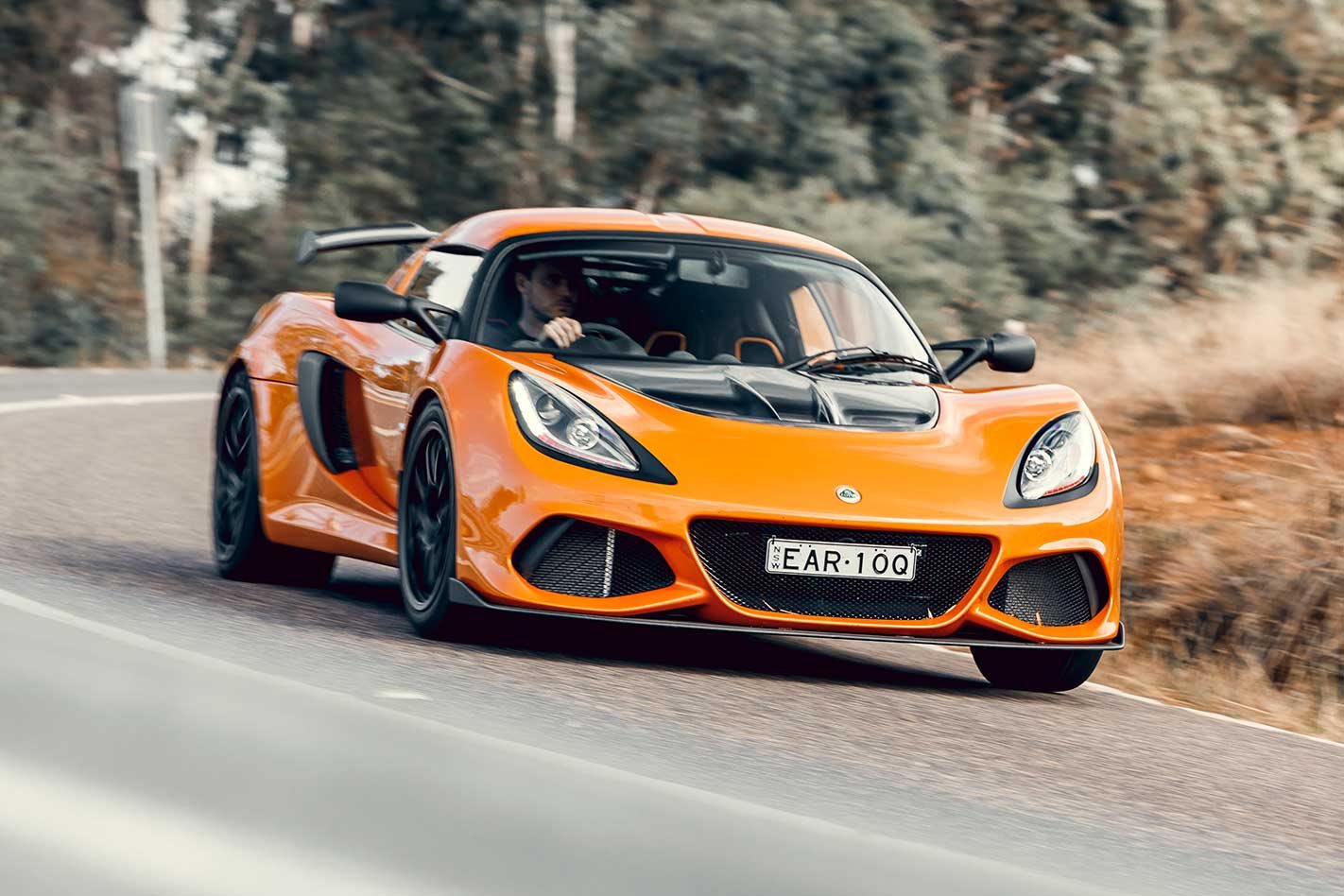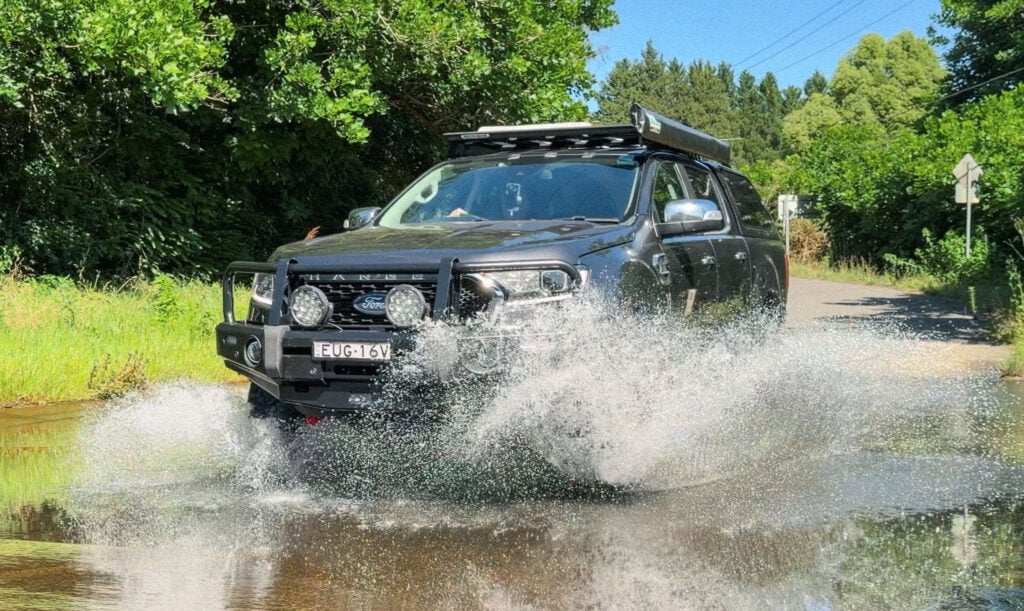Day two of Targa Tasmania 2019. Lotus Exiges occupy four of the top five places, including a comfortable outright lead for Steve Glenney. Before us and our Lotus Exige Sport 410 is 45km of one of the best tarmac rally roads in the country.
Sadly, though, the Mansfield-Whitfield road is in Victoria, not Tasmania, so instead of race suits, timing gear and marshals, we have speed limits, cyclists and crabby locals who view taking photos by the side of the road as a threat to the neighbourhood.

Nevertheless, the happenings across Bass Strait suggest we’ve chosen an appropriate route to test Hethel’s latest supercharged circuit star. In layman’s terms, it’s a harder, faster Exige – no mean feat – created by incorporating components and lessons from the ultra-hardcore Exige Cup 430. The recipe is tried-and-tested: more power, more grip, less weight.
Stripping kilograms from an Exige isn’t easy, but ultra-lightweight forged alloys (staggered 17s front, 18s rear) do their bit, as does the increased use of carbonfibre for the rear hatch and front air duct, while optioning a titanium exhaust sheds a further 10kg. The difference isn’t huge – at 1108kg, the Sport 410 is just 17kg lighter than the standard 350 – but every little bit helps.
Combine this with an extra 49kW thanks to an “engine recalibration” of the 3.5-litre supercharged V6 and the all-important power-to-weight ratio skyrockets from 228kW/tonne to 276, superior to the likes of the Porsche 911 GT3 and Nissan GT-R Nismo. A six-speed manual is the only available gearbox, but 0-100km/h is claimed to take just 3.4sec, while top speed is an impressive 290km/h.
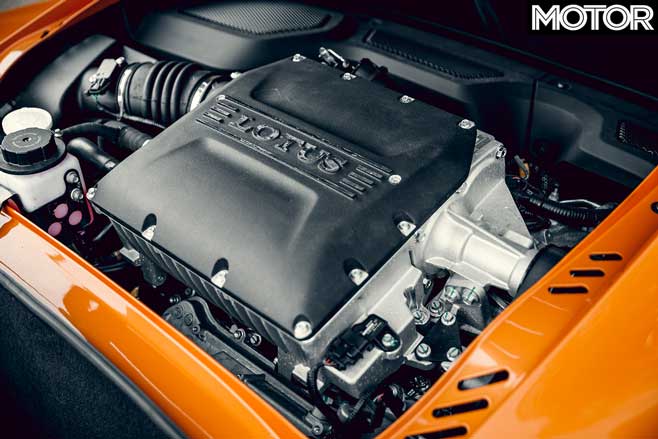
British sports car makers can be a little optimistic in their performance claims, but the Sport 410 gets in the ballpark with an impressive 3.72sec to 100km/h and an 11.82sec quarter at 192.52km/h, the fat 285mm Michelin Pilot Sport Cup 2s providing excellent drive when the clutch is dropped at just over 3000rpm. Second gear is required almost immediately, but the shift doesn’t like to be rushed; matching the official claim would require a suspension of mechanical sympathy.
What’s most impressive about the Sport 410’s pace is not its hare-like getaway – light weight and lots of grip helps here – but its sustained acceleration. For an illustration of its potency, consider the figures we recorded back in 2011 in a similarly hardcore rear-drive, manual track car, the Porsche 997.2 911 GT3 RS: 0-100km/h 4.06sec; 0-400m 12.07sec at 191.96km/h. As is often the case with supercharged engines, it doesn’t feel as quick as the numbers suggest, primarily because of the ruler-straight torque delivery, the maximum 420Nm produced from 3000-7000rpm.

It sounds twice as fast, though. It’s common knowledge that the 2GR-FE is Toyota-sourced, but it’s come a long way since it sat under the bonnet of a Camry, Aurion or RAV4. In Normal mode, it emits a muted hum with an accompaniment of supercharger whine, but select Sport and floor the throttle and as the needle swings past 4000rpm the exhausts open and bellow a soulful howl like Pavarotti singing Iron Maiden.
Find a rock wall, drop the windows and revel in one of the best-sounding engines money can buy. Yes, really.
The noise makes every drive a potential event, but in any Lotus, even one as quick as this, the engine only exists to power the chassis. Three-way adjustable Nitron dampers, tweakable Eibach anti-roll bars, grooved AP Racing brakes and those sticky Michelin Cup 2s are lifted from the Cup 430, the fastest production car to ever lap Lotus’s Hethel test track, though the Sport 410 winds the downforce back from the Cup’s 220kg to 115kg at its 290km/h top speed (45kg at the front and 70kg to the rear).
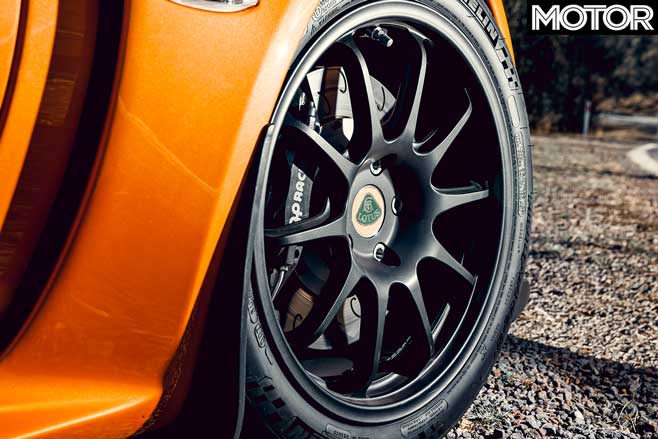
With Australia’s speed limits, the wings are more valuable for their form than their function, so the Exige looks every bit the mini supercar. Despite its appearance, it makes a decent grand tourer. Getting in and out is a massive pain thanks to the small apertures and sizeable side sills, which also force driver and passenger into close quarters.
The lack of any infotainment – it can easily be fitted, but Australian Lotus distributor Simply Sports Cars allows each customer to choose a unit to their own preferences – forces shooter Nathan and I into the lost art of conversation, but road noise isn’t sufficient to require raised voices to overcome it.
The ride is remarkably compliant for a car of this nature – certainly less fatiguing than a 911 GT3 RS driven recently – and while the seats look skeletal they offer excellent support, making the 200km schlep to Mansfield much less of a chore than you might imagine. It’s during this humdrum motoring that the engine’s mundane origins are of benefit, the V6 ticking away unobtrusively and reasonably efficiently, though the tiny 40-litre tank limits range.
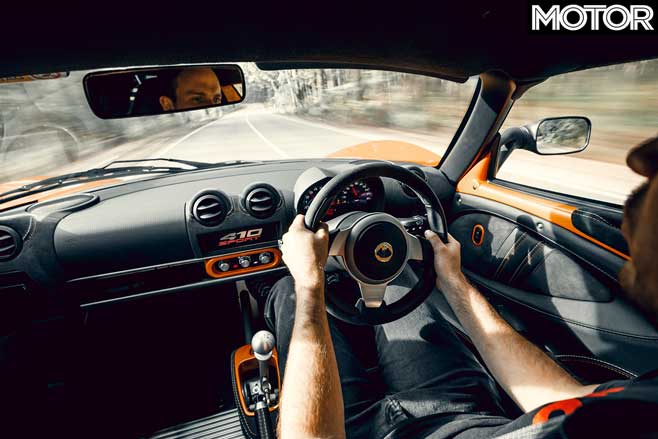
Mansfield-Whitfield Road is a key component of Targa High Country. It’s split into three stages, each with its own unique character. Attacked in an easterly direction, it begins with smooth-surface corners of varying radii snaking their way uphill. Unlike many modern performance cars, you don’t immediately attack in an Exige, primarily due to the unassisted steering. Cornering quickly requires considerable physical effort, particularly at the speeds this Sport 410 is capable of, and is only made worse initially as your body tenses in response to the unusual sensations.
The corners open as the road winds through Tolmie before tightening and narrowing; as the kilometres pass, you learn to trust the Exige, the front-end wiggles over bumps and cambers no longer eliciting a reaction. Relax and the lack of power assistance begins to make some sense thanks to the flow of unfiltered information from the front tyres.
Selecting Race mode slackens the stability control; it can be turned off, but there’s little point, as it’s not a car that you’d provoke out of shape without plenty of space to gather it up. Especially because, if ever it did get out of shape, it would be going at a serious rate of knots.

The final blast into Whitfield is a succession of downhill, high-speed sweepers with random bumps and the odd hairpin thrown in for good measure. It’s a rapid descent, the Exige possessing acceleration, deceleration and lateral grip in abundance. It’s not difficult to see why Exiges are occupying the pointy end of Targa competition, though those behind the wheel must be pedalling awfully hard.
The biggest bugbear concerns the brakes. Certainly not their effectiveness – 100-0km/h takes just 32.48m – but the pedal is set quite high. There is a sponginess to its initial travel that makes heel-and-toeing relatively easy, but the difference in height between accelerator and brake is such that quick swaps between the two require concentration. The pedal set-up is actually ideal for left-foot braking, but you’re left with the conundrum of two feet and three pedals – not impossible, but you don’t want to mess it up.
Winton Raceway is the perfect playground to let the Exige do what it’s designed to, and bring that downforce into play. Or it would be, if it didn’t currently offer all the grip of a greasy smartphone. Even with Race mode engaged (retaining the ESP safety net), the Sport 410 is lively, wiggling its hips under braking and power, but with each passing lap temperature builds, the track dries and the Lotus reveals layers of ability.

It has little interest in flattering your skills (or lack of). For better or worse, it will precisely obey your commands; get lazy with your brake release on corner entry and the rear will step smartly sideways; accelerate too aggressively and the nose will push wide; fail to focus on that quick gearshift and it won’t necessarily just slide into place. It requires focus, and the steering requires muscle as well.
Lotus purists will no doubt be aghast, but the Exige would be a more enjoyable car with power steering. The trouble lies in the fact that you’re scared to push the ultimate limits because in the back of your mind you know you’ll never be able to catch it if it does let go.
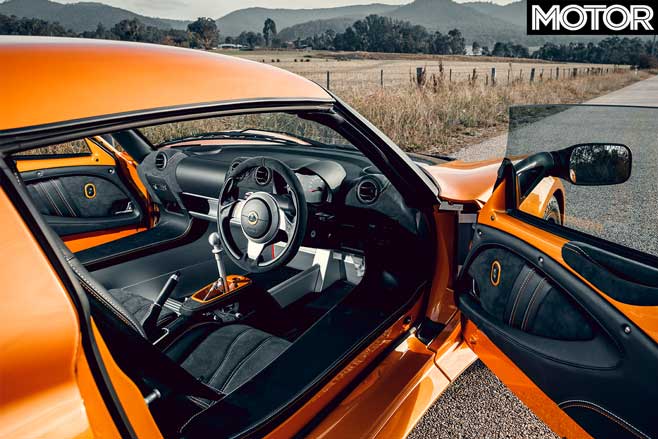
Resident hot-shoe Warren Luff agrees: “It’s not an easy car to drive on the limit. You’ve got to be so incredibly smooth, otherwise it wants to break into massive understeer or snap oversteer. It doesn’t compensate for any possible mistakes of the driver. You’ve got no confidence to tip it in with any speed for fear it’s going to break away [because] you know that when it lets go there’s no coming back.”
Seriously, how much can power steering weigh? The Evora shows what Lotus can achieve with assisted steering.
On a dry but still slippery Winton, his Luffster manages a best of 1:35.16, a somewhat disappointing time given we’ve previously clocked a Porsche 718 Cayman S at 1:33.1. Mark O’Connor from Simply Sports Cars says customers have recorded mid-1:32s, so it’s possible track conditions were simply far from ideal for hot-lapping.
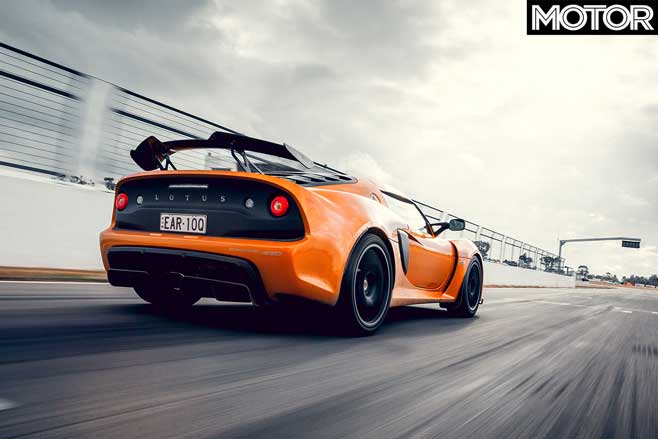
It must be said that up to nine-tenths or so the Exige is excellent: stable, fast, grippy and doesn’t even begin to break a sweat. Accessing that final 10 per cent, however, takes an extremely high level of skill. The difference between a good driver and an average one in the Exige would be wider than in most cars.
But where there is challenge there is also reward. Because the Sport 410 doesn’t flatter to deceive, you know that whatever lap time you have achieved is the work of you alone. Extracting its best isn’t easy, but nothing worthwhile ever is; put the work in and the Exige will make you a better driver. And if you’re already a brilliant driver, there’s the knowledge that the sky’s the limit – even the top step of the Targa Tasmania podium.
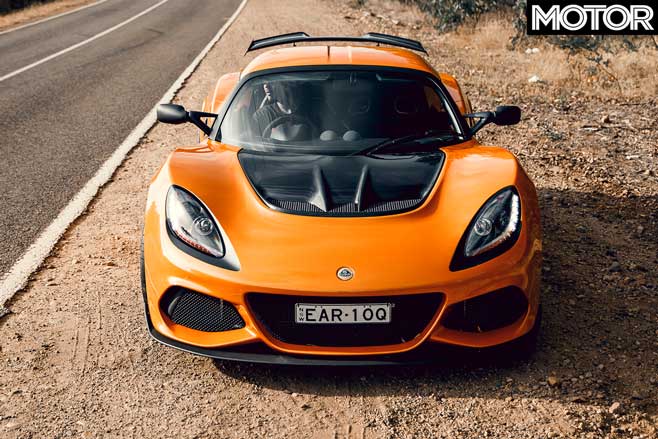
FAST FACTS 2019 Lotus Exige Sport 410 BODY: 2-door, 2-seat coupe DRIVE: rear-wheel ENGINE: 3456cc V6, DOHC, 24v, supercharged BORE/STROKE: 94.0 x 83.0mm COMPRESSION: 10.8:1 POWER: 306kW @ 7000rpm TORQUE: 420Nm @ 3000-7000rpm WEIGHT: 1108kg POWER-TO-WEIGHT: 276kW/tonne TRANSMISSION: 6-speed manual SUSPENSION: double wishbones, coil springs, anti-roll bar (f/r) L/W/h: 4084/1802/1129mm WHEELBASE: 2370mm TRACKS: 1499/1548mm (f/r) STEERING: unassisted rack-and-pinion BRAKES: 332mm ventilated/grooved discs, 4-piston calipers (f/r) WHEELS: 17.0 x 7.5-inch (f); 18.0 x 10.0-inch (r) TYRES: Michelin Pilot Sport Cup 2, 215/45 R17 (f); 285/30 R18 (r) PRICE: $159,990 ($165,515 as tested)
PROS: Outright speed; looks; track ability; what a noise! CONS: Getting in and out; tricky at the limit; compromised RATING: 3.5 out of 5 stars
The Strip
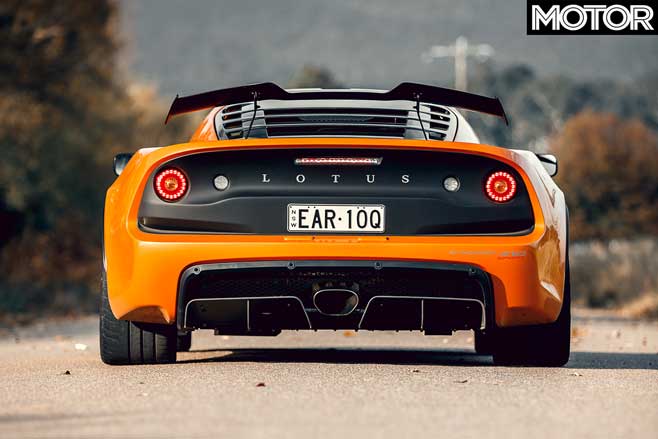
| Lotus Exige Sport 410 | |
| 0-10km/h | 0.22sec |
| 0-20km/h | 0.51sec |
| 0-30km/h | 0.78sec |
| 0-40km/h | 1.07sec |
| 0-50km/h | 1.40sec |
| 0-60km/h | 1.74sec |
| 0-70km/h | 2.38sec |
| 0-80km/h | 2.78sec |
| 0-90km/h | 3.25sec |
| 0-100km/h | 3.72sec |
| 0-110km/h | 4.23sec |
| 0-120km/h | 5.10sec |
| 0-130km/h | 5.75sec |
| 0-140km/h | 6.43sec |
| 0-150km/h | 7.14sec |
| 0-160km/h | 8.38sec |
| 0-170km/h | 9.36sec |
| 0-180km/h | 10.39sec |
| 0-190km/h | 11.56sec |
| 0-400m | 11.82sec @ 191.52km/h |
| 80-120km/h (3rd-6th) | 2.5/3.3/4.6/5.3sec |
| 100-0km/h | 32.48m |
| Speed in gears | |
| 1st | 62km/h @ 7000rpm |
| 2nd | 115km/h @ 7000rpm |
| 3rd | 156km/h @ 7000rpm |
| 4th | 201km/h @ 7000rpm |
| 5th | 264km/h @ 7000rpm |
| 6th | 280km/h @ 6600rpm* |
Winton Raceway, 12˚C, dry. Driver: Scott Newman *Manufacturer’s claim Official timing supplier: www.vboxaustralia.com.au


